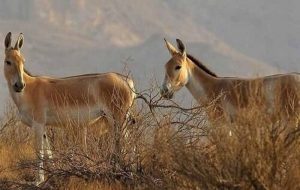Newly-born zebras promise saving species from extinction
TEHRAN –The birth of odd-toed herbivorous zebras in Garmsar Desert National Park promises to bring the valuable species back from extinction with its population anticipated to reach 50 from currently 36 in the near future. Garmsar Desert National Park, located in the west of Semnan province, is one of the primary habitats of the Persian


TEHRAN –The birth of odd-toed herbivorous zebras in Garmsar Desert National Park promises to bring the valuable species back from extinction with its population anticipated to reach 50 from currently 36 in the near future.
Garmsar Desert National Park, located in the west of Semnan province, is one of the primary habitats of the Persian zebra in the country.
The breeding season of zebras commences in the middle of spring. Their births at the proper time in the desert national park promise their survival, IRNA quoted Bahram-Ali Zahiri, an official with the Department of Environment (DOE), as saying.
The Persian zebra is a subspecies of onager, which is critically in danger of extinction. Onagers used to have a large population in West Asia, Central Asia, and China, but now it has become extinct in most areas, Zahiri added.
Based on the latest reports, out of 36 zebras inhabiting Semnan Desert National Park, 11 are immature and the rest are adults, he added.
“At three years old, zebras reach maturity. As 11 immature zebras in the desert national park reach reproductive age, we can be optimistic on having a stable population of more than 50 zebras,” the official highlighted.
Zahiri stressed the birth of a zebra foal from different parents and outside of familial relationships is an important factor in preventing genetic disorders and ensuring the well-being of this valuable species.
In order to create genetic diversity, an adult male was relocated from Turan National Park in Shahroud to Garmasar Desert National Park last year, similar transfer is planned to take place again this year.
Persian zebra is one of the most prominent herbivore species, which had been extinct for about 30 years in Garmsar Desert National Park.
In the first stage of an attempt to revive the species, the efforts focused on its breeding in captivity. The second stage involved releasing species of wildlife and reintroducing them to their habitat, the official said.
Zebras’ low population is due to several reasons. They have poor reproduction ability, with one out of every three foals of this species surviving.
The probability of male zebra foal survival is poor because the male zebra does not accept the male foal and kills it causing a decline in the zebra population.
The official noted that long gestation period and lack of twin pregnancy are the other effective factors in low population of zebras in Iran.
In the Iranian year 1397 (2018 – 2019), 10 zebras were transferred from Turan National Park in Shahroud to Garmsar Desert National Park with the aim of reintroducing the species to its previous habitat; only five zebras survived.
Later, four more zebras were transferred from the Gourab breeding site in Yazd province to Semnan Desert National Park.
Endangered species
More than 8,000, 2,000, and 25,000 species of plants, vertebrates, and invertebrates, respectively, show Iran’s rich biodiversity and the importance of its preservation.
Wildlife conservation, which includes protecting all living things on the planet, plant and animal species, and microorganisms, means preserving the components of a large network. A network wherein all the components are interconnected and depend on each other in different ways.
People everywhere rely on wildlife and biodiversity-based resources to meet their needs – from food, to fuel, medicines, housing, and clothing. By saving wildlife we protect all forms of life on the planet, ourselves, and ultimately maintain the balance of life on the earth.
There are many threats to endangered wildlife species, including mammals, reptiles, amphibians, fish, and birds.
Habitat destruction, fragmentation, and modification caused by human-led activities such as industrial and residential development, logging, crop farming, livestock grazing, mining, road and dam building, and pesticide use have taken an extreme toll on threatened and endangered wildlife populations at an alarming rate.
Currently, about 128 species of animals and vertebrates in the country are at risk of extinction, some of which are not in good condition, and amphibians are the most vulnerable in this area.
MT/MG
